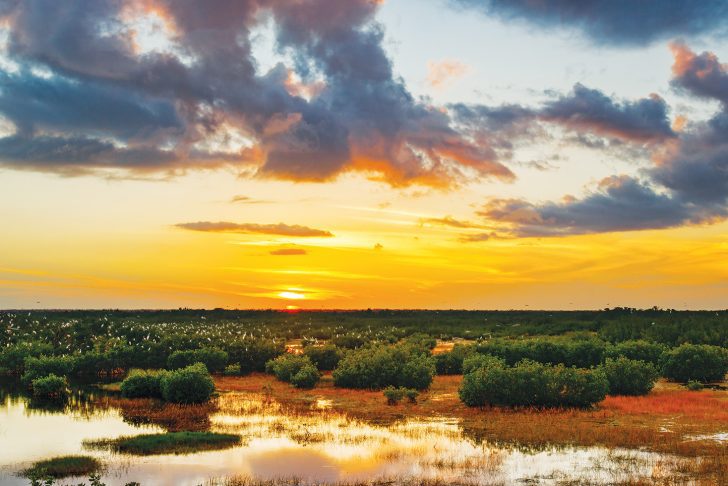Capt. Tim Ramsey
Usually in fishing you go with what feels right. The wind kicks up and you go searching for the quiet spots in the backcountry. Tide heads out and you fish toward bigger water and avoid the backcountry. Water gets colder and you avoid the beach. Ever think of doing the opposite?
I always cursed the wind. It sends your casts off course, pushes the boat in unwanted directions, and often makes a day generally uncomfortable. I always paid strict attention to the tides. I didn’t want to get caught somewhere remote or run over something I couldn’t clear. I was stuck on “incoming tide means bait. Incoming tide means safe operation.” Then I challenged those beliefs.
One day, as the tide was going out and wind blowing straight into the backcountry, I decided to head as far back as I could. I rounded the corner of a favorite bay I often use to escape the wind, lowered the trolling motor, and decided to skip the leeward side and fish the exposed, “getting shallower every moment” windward side. The boat caught the wind. I was constantly on the trolling motor and Power Pole remotes, but I kept the Skeeter within casting distance. The water was mere inches deep under the trees, so I didn’t have to be as accurate as possible. Result? I had a banner snook and redfish day.
With this success in mind, I fished the windier points and mangrove banks in other familiar places while reminding myself I have enough experience in the backcountry to fish whatever tide I like. I had equal success. I noted that windy spots with shade are even more productive. Sure, you have to do a bunch more boat handling and retrieving a stuck jig or lure can get a bit tricky, but the payoffs can be great. As for the beach, fish have been there all year and bluefish have been everywhere. Snook and reds appeared out front all year so the old philosophies about their location are constantly challenged.
With this experience in mind, I’ve established a few new assumptions and beliefs based on observation. Fish don’t care if the tide is coming in or out. They want the water moving. Hard to be an ambush feeder in still water. Wind pushes bait against the mangroves so your calm side is vastly less productive than the windy side. Windy side means you won’t sweat as much or get eaten by mosquitoes so badly. Embrace low tide in the backcountry. The fish have to go somewhere when the roots are dry. Going back when the water is low teaches you not just about navigation, but fish movement and tidal flow. High tide isn’t always your friend. Too much water is too much water.
Remember, take it easy in the backcountry. Don’t cross grass flats if you might dig them up. That ripple you see might not be fast water but the top of a barely submerged oyster bar. Respect others and don’t wake them. Not only does it rock them, but it stirs up mud along the mangroves. Be careful when on your trolling motor upwind of a mangrove bank or oyster bar. It’s surprising how fast the wind can push you into trouble. See you out there.

